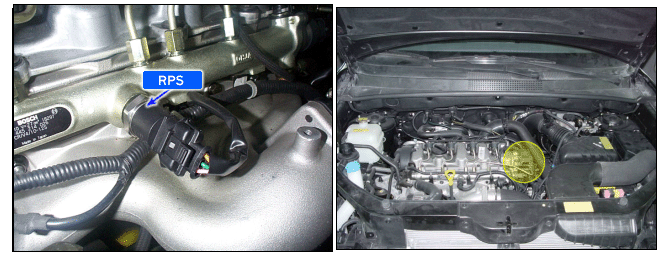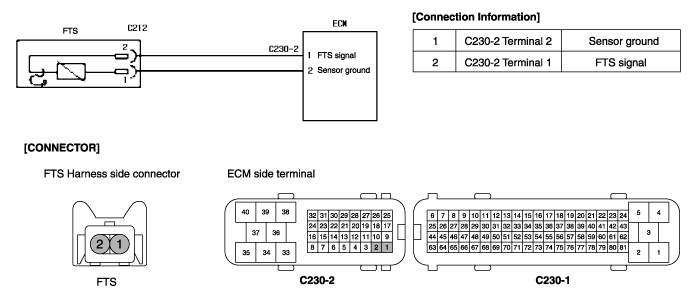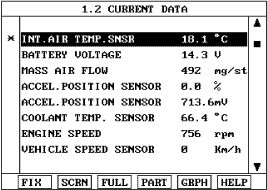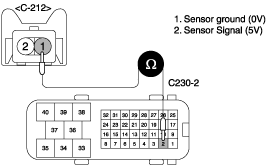Has a problem been found?

Repair as necessary and go to "Verification of Vehicle Repair" procedure.

Go to "Signal Circuit Inspection" procedure.

FTS(Fuel Temperature Sensor) located in the engine fuel passage from the fuel tank.
It detects the fuel temperature and relays signals to the ECM.
It employs a thermistor, which is sensitive to changes in the fuel temperature.
The electric resistance of a thermistor decreases as the temperature increases, and increases as the temperature decreases.
The power source in the ECM is supplied to the FTS via a resistor in the ECM.
It is used during injection control strategies that make corrections depending on the fuel temperature and in order to protect the system in event of excessive fuel temperature.
In case of more than FTS 120°C, the engine symptom generates the power loss or poor acceleration.
If the signal is above threshold value, the ECM judged this as a fault and DTC is set.
Item | Detecting Condition | Possible Cause |
DTC Strategy | ● Signal check, high | ● Short to ground in signal circuit ● Open in ground circuit ● Faulty FTS ● Faulty ECM |
Enable Conditions | ● Ignition on | |
Threshold Value | ● Output signal > 4.9V | |
Diagnostic Time | ● 0.48 sec. | |
MIL Fuel Limit Fuel Cut EGR Off | ● No ● No ● No ● Yes | |
Fail safe | ● Engine fuel temperature is fixed at value of 60°C by ECM. |
IATS | |||
Temperature (°C) | 20 | 40 | 60 |
Resistance (kΩ) | 2.27 ~ 2.73 | 1.06 ~ 1.28 | 0.54 ~ 0.65 |


Connect scantool to Data Link Cable (DLC).
Warm up engine to normal operating temperature.
Monitor "Fuel Temperature Sensor" parameter on the scantool.

Fig 1) Signal decreases with increasing sensor temperature and increases with decreasing sensor temperature.
Is Current data displayed correctly ?

▶ Fault is intermittent caused by poor contact in the sensor’s and/or ECM’s connector or was repaired and ECM memory was not cleared. Thoroughly check connectors for looseness, poor connection, bending, corrosion, contamination, deterioration, or damage. Repair or replace as necessary and go to "Verification of Vehicle Repair" procedure.

▶ Go to "W/Harness Inspection" procedure.
Many malfunctions in the electrical system are caused by poor harness and terminals.
Faults can also be caused by interference from other electrical systems, and mechanical or chemical damage.
Thoroughly check connectors for looseness, poor connection, bending, corrosion, contamination, deterioration, or damage.
Has a problem been found?

Repair as necessary and go to "Verification of Vehicle Repair" procedure.

Go to "Signal Circuit Inspection" procedure.
Ignition "OFF"
Disconnect FT sensor connector.
Measure voltage between terminal 2 of the sensor harness connector and chassis ground.
Specification : 4.8 ~ 5.1V

Is the measured voltage within specifications ?

▶ Go to "Component Inspection" procedure.

▶ Check for short to ground in harness. Repair as necessary and go to "Verification of Vehicle Repair" procedure.
Ignition "OFF".
Disconnect FT sensor connector and ECM connector.
Measure resistance between terminal 1 of the sensor harness connector and terminal 2 of ECM harness connector.

Is the measured resistance within specifications ?

▶ Go to "Component Inspection" procedure.

▶ Check for open in harness.
Repair as necessary and go to "Verification of Vehicle Repair" procedure.
Check Fuel Temperature Sensor
Ignition "OFF"
Disconnect FTS connector.
Measure resistance between terminals 1 and 2 of the FT sensor connector(Component side).
Temperature (°C) | 20 | 40 | 60 |
Resistance (kΩ) | 2.27 ~ 2.73 | 1.06 ~ 1.28 | 0.54 ~ 0.65 |

Is the measrued resistance within specifications ?

▶ Substitute with a known-good ECM and check for proper operation.
If the problem is corrected, replace ECM and then go to "Verification of Vehicle Repair" procedure.

▶ Substitute with a known-good FTS and check for proper operation.
If the problem is corrected, replace FTS and then go to "Verification of Vehicle Repair" procedure.
After a repair, it is essential to verify that the fault has been corrected.
Connect scan tool and select "Diagnostic Trouble Codes(DTCs)" mode and then clear DTC.
Operate the vehicle within DTC Enable conditions in General information.
Are any DTCs present ?

Go to the applicable troubleshooting procedure.

System is performing to specification at this time.